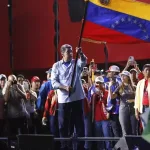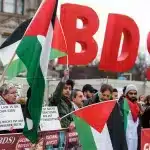
By Fereshteh Sadeghi – May 21, 2024
The Islamic Republic’s loss of its eighth president and top diplomat has raised concerns about its political future. Still, dramatic changes should not be expected so long as the replacements come from the same circle as the late officials.
On Sunday, 19 May, Iranian media began reporting on an incident involving a helicopter carrying President Ebrahim Raisi, Foreign Minister Hossein Amir-Abdollahian, the Imam of Friday Prayer for the city of Tabriz, and the newly appointed governor of the East Azerbaijan province.
Alongside other provincial and government officials, the group was returning from inaugurating a water dam at Iran’s northwest border with Azerbaijani President Ilham Aliyev.
With search and rescue operations dragging into a blanket of fog in Iran’s mountainous northwest, any hopes of finding survivors diminished through the early hours of Monday, and the Iranian government declared the passing of the eighth president alongside seven of his companions.

Soon after the news was confirmed, all attention became focused on two issues: what would happen next and who would replace the late president and foreign minister.
As Article 131 of the Iranian Constitution states, in the event of a president’s absence, death, or resignation, the vice president assumes responsibility and acts as the caretaker head of the government. In this case, the first Vice President, Mohammad Mokhber, was immediately mandated by Supreme Leader Ali Khamenei to take charge.
The same constitutional article states that the interim head of the government, the speaker of parliament, and the head of the judiciary must prepare the groundwork for a new presidential election within 50 days.
On the same day, the newly sworn-in interim government announced that elections would occur on 28 June.
Candidates running to replace Raisi will officially be declared three weeks before the ballots, as per Iranian law.
Interim head of government
Interim President Mokhber is already a likely candidate. Mohammad Mokhber Dezfuli, renowned among Iranian executive elites for years, hails from a clerical family in the oil-rich Khouzestan province. He has two PhDs in economic development and international relations and began his climb of the power ladder by joining the financial entities supervised by Iran’s supreme leader.
He joined the Mostazafan Foundation and its financial arm, Sina Bank. In 2007, Khamenei appointed him president of the Executive Headquarters of Imam Khomeini’s Directive, usually abbreviated as “Setad.”
Setad is a wealthy conglomerate under Khamenei’s direct supervision. Setad’s president must be trustworthy and loyal to his boss, as the position only reports to the leader and his office. In addition, no state organization can interfere in Setad’s affairs. This makes an individual presiding over the Setad someone who wields much power.
Mokhber stepped to the fore of Iran’s political scene after Raisi won the 2021 election. As a former top justice, Raisi chose Mokhber as the executive face of his government. If elected as the ninth president of Iran in late June, Mokhber will likely continue on the same path as Raisi, since he was already the driver behind the wheel of the eighth Iranian government.
Iranian President’s Death Latest in String of Strange Coincidences
Who steps into Amir-Abdollahian’s shoes?
The second immediate matter to resolve after the tragic helicopter crash was to find a replacement for Foreign Minister Hossein Amir-Abdollahian, as the Islamic Republic could not afford to let his absence harm or disrupt its diplomatic efforts in West Asia.
Since the start of Operation Al-Aqsa Flood by the Palestinian resistance against Israel on 7 October, Amir-Abdollahian kept a busy schedule, traveling to numerous Arab and European capitals and even further to the UN, garnering support for Palestinians and advancing Iran’s strategies for the Axis of Resistance.
Therefore, in his first order of business, Mokhber appointed Ali Bagheri Kani, the political affairs deputy to Amir-Abdollahian and Iran’s top nuclear negotiator, as the head of “the government’s foreign relations committee.”
Similar to Mokhber, Bagheri Kani comes from a clerical family. His father, Ayatollah Mohammad-Bagher Bagheri Kani, was a member of the Assembly of Experts that chooses Iran’s leader. His brother Mesbah ul-Huda Bagheri Kani is married to Khamenei’s daughter.
Ali’s uncle, Ayatollah Mohammad-Reza Mahdavi Kani (1931–2014), is a famous conservative politician who briefly served as prime minister and interior minister in 1981. However, his most important roles were leading a major clerical group, the Combatant Clergy Association, and acting as dean of Imam Sadeq University for over three decades.
The Imam Sadeq University is often described as a “factory” that produced at least two generations of executives loyal to the Islamic Republic, its leaders, causes, and policies. It is also Bagheri Kani’s alma mater, in which he later taught economics.
Bagheri Kani joined the Foreign Ministry in his late 20s and headed the MENA and later Central European departments of the Iranian Foreign Ministry.
However, his close relations with conservative politician Saeed Jalili (another Imam Sadeq alumni) led him to continue as a deputy to the then-secretary of the Supreme National Security Council and top nuclear negotiator from 2007 to 2013.
Bagheri Kani’s star rose again when Amir-Abdollahian invited him to return to the Foreign Ministry and participate in the nuclear talks between Iran and the P5+1 nations – China, France, Russia, the UK, and the US plus Germany. And so, Bagheri Kani had led some of the most crucial negotiations of the Islamic Republic’s history.
The talks, nevertheless, failed to revive the 2015 Joint Comprehensive Plan of Action (JCPOA), a nuclear agreement that was comatosed after Washington unilaterally walked away in 2018.
Bagheri Kani is known as a serious and soft-spoken diplomat, and three years of direct contact with western and regional diplomats have given the latter enough time to get to know him. With the late foreign minister Amir-Abdollahian – who enjoyed good and years-long relations with Arab capitals – joining history, it is now time for Bagheri Kani to advance Iran’s strategies worldwide, particularly in West Asia.
Iran’s future foreign policy: A path of continuity
The future direction of Iran’s foreign policy appears to be set on a course of continuity, regardless of whether Mohammad Mokhber wins June’s elections. Given its proven effectiveness, Raisi’s legacy of prioritizing Iran’s interests domestically and his “Look to the East” approach to foreign policy will likely persist under his successor.
In contrast to predecessor Hassan Rouhani’s aspirations for improved relations with the west, Raisi’s approach emphasized strengthening ties with Russia, China, and other Global South nations. His efforts have elevated Tehran’s standing in this geopolitical scene to one of leadership alongside Beijing and Moscow. Raisi’s diplomatic initiatives, including visits to Latin America and Africa, have continued to expand Iran’s influence on the global stage.
Raisi’s successor will probably follow his political path of success, maintaining domestic and foreign policy continuity. As such, Iran’s strategic orientation toward the east and the consolidation of its position in the Global South are likely to remain key pillars of its foreign policy agenda in the coming years.
- Orinoco Tribune 2https://orinocotribune.com/author/yullma/September 19, 2025
- Orinoco Tribune 2https://orinocotribune.com/author/yullma/September 19, 2025
- Orinoco Tribune 2https://orinocotribune.com/author/yullma/September 18, 2025
- Orinoco Tribune 2https://orinocotribune.com/author/yullma/September 16, 2025





